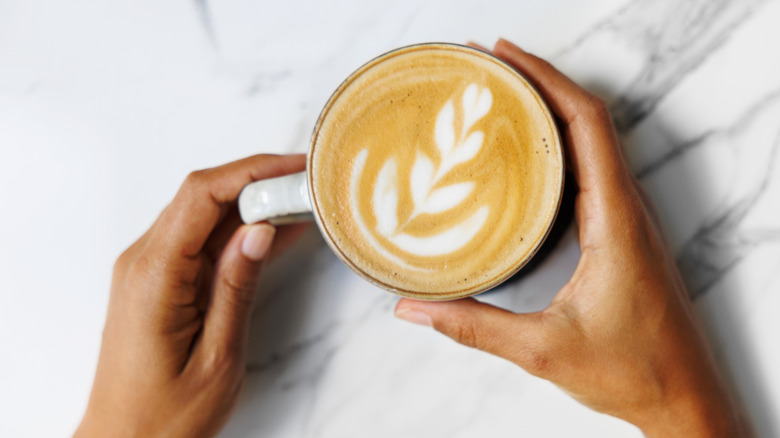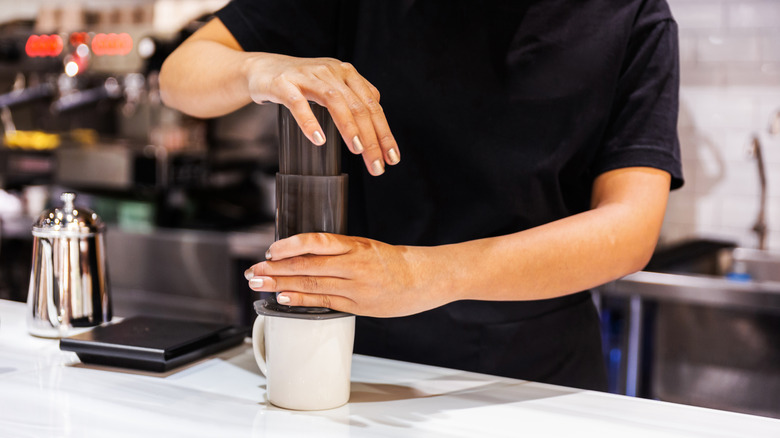Ever Wonder Why Coffee Tastes Better At Cafés?
We may receive a commission on purchases made from links.
There's something about café coffee that just hits different. Whether it's a silky flat white or a strong double espresso, the flavor, texture, and aroma seem impossible to replicate at home. So what's the secret? We asked former barista Matt Woodburn-Simmonds of Home Coffee Expert to break down exactly why coffee tastes better at a café, and how close you can get from your own kitchen.
"They are likely using freshly roasted beans that have been ground to order," Woodburn-Simmonds says. "Having super fresh ground coffee means more flavor from the beans can get into your cup." Espresso machines and grinders are carefully tuned, with every variable — grind size, dose, temperature, and extraction time — calibrated to get the best out of the coffee. "Doing this hundreds of times a day builds consistency and speed," Woodburn-Simmonds explains.
There's also the matter of equipment. The best coffee makers offer stable pressure, consistent heat, and powerful steam wands; all crucial to achieving balanced espresso and perfectly textured milk. And then there's the human element. Baristas steam milk hundreds of times a day, and as Woodburn-Simmonds points out, making a dozen or so coffees at home doesn't provide nearly the amount of practice you get whipping up thousands a week. "The repetition, as long as standards are set, means they get extremely good at always nailing the milk texture or pour over extraction, or espresso shot quality," he explains.
How can you make your coffee taste like a café cup?
Matt Woodburn-Simmonds also has some tips for coffee fanatics wanting to recreate their much-loved order at home. The biggest upgrade you can make is using high-quality beans that have been roasted around two weeks ago, and grinding them fresh every time, he tells Chowhound. That alone can transform your brew from flat to flavorful.
But it's not just about the beans. To get café-level results, you'll need to pay attention to the details: grind size, water temperature, coffee dose, and how long your coffee brews. Woodburn-Simmonds calls it "dialing in" — and once you get those variables right, consistency follows. If you're home brewing, clean, filtered water with a balanced mineral concentration is the best type of water to brew coffee with, and stand-out coffee bean brands include Death Wish Dark Roast Coffee, or for a lighter touch, Five Five Coffee's Ethiopia blend.
If you're on a budget, Woodburn-Simmonds recommends the AeroPress paired with a quality hand grinder like one from 1Zpresso. While it won't make true espresso, it comes impressively close and delivers rich, smooth coffee that rivals some café drinks.
For latte lovers or anyone who wants real milk-based drinks at home, an espresso machine with a steam wand is essential. Matt Woodburn-Simmonds' suggested setup is a unit like the Breville Bambino Espresso Machine and a 1Zpresso J-Ultra Manual Coffee Grinder. Together, they deliver coffee-shop quality for around $500. And for those sweet, flavored drinks? Monin syrups are what most cafés use. He explains, "They have a very wide range of options, so you should be able to find your favorite flavor pretty easily." So, with a little effort and the right tools, you really can bring the café experience home.

